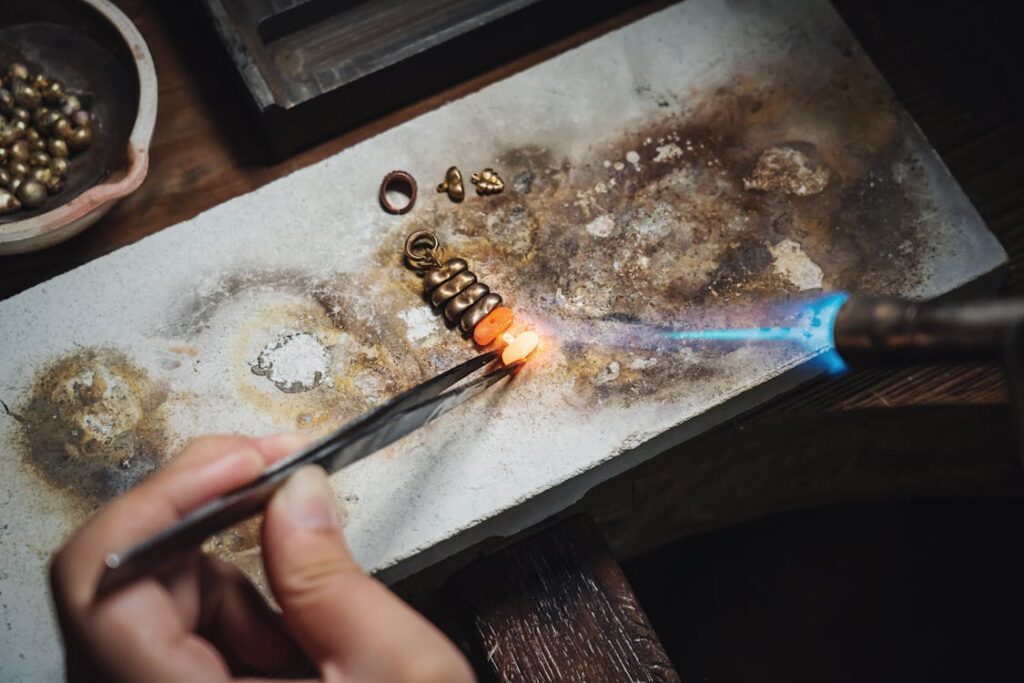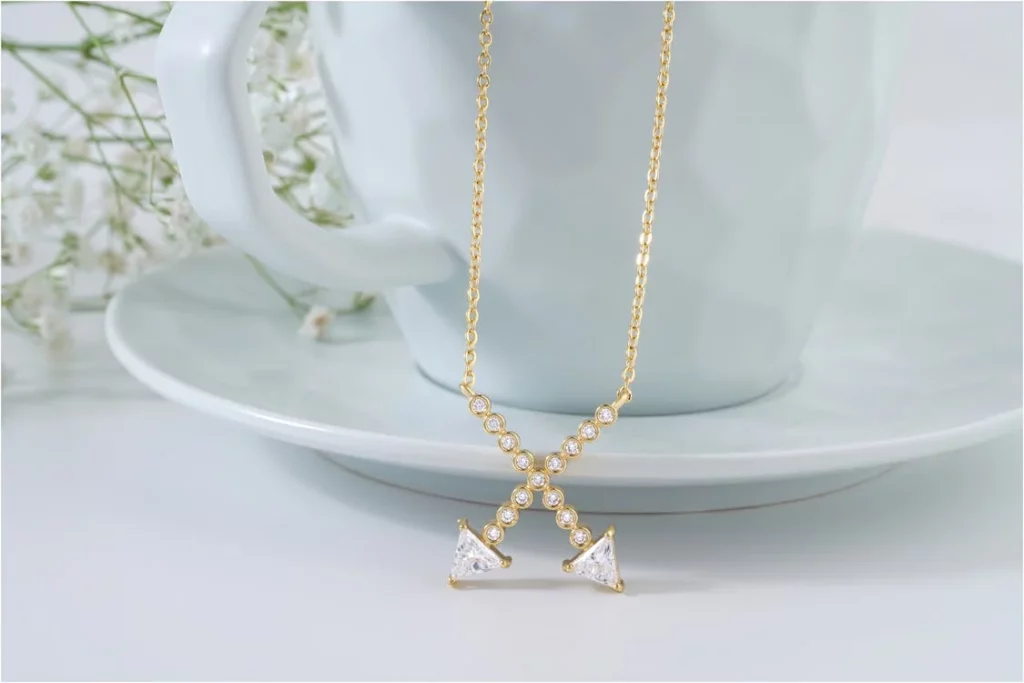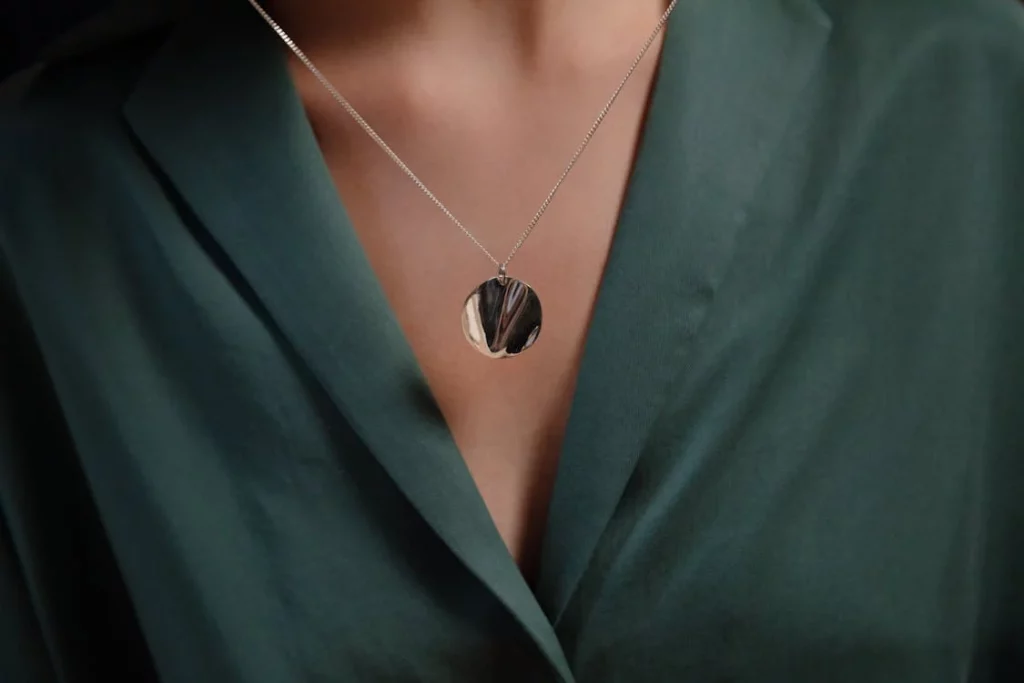In der Schmuckherstellung konkurrieren zwei prominente Techniken um Aufmerksamkeit: PVD-Beschichtung und Galvanisierung. Beide Methoden bieten einzigartige Vorteile und beeinflussen die Qualität, Haltbarkeit und Ästhetik des Endprodukts. Das Verständnis der Feinheiten beider Techniken ist für Schmuckhandwerker und -liebhaber gleichermaßen unerlässlich. Ein umfassender Vergleich beleuchtet die Nuancen zwischen PVD-Beschichtung und Galvanisierung.

Was ist eine PVD-Beschichtung?
PVD (Physical Vapor Deposition) ist ein anspruchsvolles Verfahren, bei dem dünne Materialschichten im Vakuum auf Oberflächen abgeschieden werden. Im Gegensatz zu herkömmlichen Beschichtungsverfahren arbeitet die PVD-Beschichtung auf atomarer Ebene und gewährleistet so außergewöhnliche Haftung und Gleichmäßigkeit. Diese Technik nutzt energiereiche Quellen wie Plasma- oder Lichtbogenverdampfung, um feste Materialien zu verdampfen und gasförmig zu machen. Die verdampften Partikel kondensieren anschließend auf dem Substrat und bilden eine langlebige Beschichtung mit verbesserten Eigenschaften.
Prozess der PVD-Beschichtung
Der PVD-Beschichtungsprozess in der Schmuckherstellung umfasst mehrere sorgfältige Schritte, um dünne Materialschichten im Vakuum auf Schmucksubstrate aufzutragen. Hier finden Sie eine detaillierte Übersicht über den PVD-Beschichtungsprozess, der speziell auf die Schmuckherstellung zugeschnitten ist:
- Reinigung und Vorbereitung von Schmuck: Die Schmuckstücke werden gründlich gereinigt und vorbereitet, um Schmutz, Öle und Rückstände zu entfernen, die die Haftung beeinträchtigen könnten. Dieser Schritt ist entscheidend für eine gute Verbindung zwischen der Schmuckoberfläche und der aufgetragenen Beschichtung.
- Befestigung und Platzierung in der VakuumkammerDie gereinigten Schmuckstücke werden sorgfältig fixiert und in eine für die PVD-Beschichtung vorgesehene Vakuumkammer gelegt. Die richtige Fixierung gewährleistet eine gleichmäßige Beschichtung und minimiert handhabungsbedingte Verunreinigungen. Anschließend wird die Vakuumkammer evakuiert, um einen Unterdruck zu erzeugen, der typischerweise unter dem atmosphärischen Druck liegt.
- Oberflächenaktivierung und -reinigungVor der Beschichtung können die Schmuckoberflächen einer Oberflächenaktivierung und Reinigung unterzogen werden, um die Haftung zu verbessern. Dies kann durch Ionenbeschuss oder Plasmareinigung geschehen, um Oberflächenverunreinigungen zu entfernen und die Oberflächenrauheit zu erhöhen, wodurch die Aufnahmefähigkeit des Substrats für das Beschichtungsmaterial verbessert wird.
- MaterialabscheidungDas Beschichtungsmaterial, oft in Form eines festen Targets oder einer festen Quelle, wird mithilfe von Hochenergiequellen wie Elektronenstrahlen, Sputtertargets oder Lichtbogenverdampfung verdampft. Das verdampfte Material kondensiert anschließend auf den Schmuckoberflächen und bildet einen dünnen Film bzw. eine Beschichtung. Dieser Abscheidungsprozess erfolgt kontrolliert im Vakuum, um eine gleichmäßige Beschichtung und Haftung auf den Schmucksubstraten zu gewährleisten.
- Kontrollierte Dicke und Zusammensetzung: Die Dicke und Zusammensetzung der aufgetragenen Beschichtung werden durch die Anpassung von Prozessparametern wie Beschichtungsrate, Substrattemperatur und Beschichtungszeit sorgfältig kontrolliert. Diese präzise Kontrolle gewährleistet eine gleichmäßige Beschichtungsdicke und die gewünschten Materialeigenschaften bei allen Schmuckstücken.
- Nachbehandlung nach der Beschichtung (optional): Je nach gewünschten Eigenschaften und Ästhetik können die beschichteten Schmuckstücke nach der Beschichtung behandelt werden, z. B. durch Polieren, Schleifen oder Oberflächenstrukturieren, um das Aussehen und die Haptik des Endprodukts zu verbessern. Diese Behandlungen können die Oberflächenbeschaffenheit weiter verfeinern und die Gesamtqualität des beschichteten Schmucks verbessern.
- Qualitätsprüfung und -sicherung: Nach Abschluss des PVD-Beschichtungsprozesses werden die beschichteten Schmuckstücke einer gründlichen Qualitätskontrolle unterzogen, um die Einhaltung der Spezifikationen und Normen sicherzustellen. Dies kann eine Sichtprüfung, die Messung der Schichtdicke, Haftungsprüfungen sowie die Beurteilung der Oberflächenbeschaffenheit und des Aussehens umfassen.
Arten der PVD-Beschichtung
Die PVD-Beschichtung umfasst ein breites Spektrum an Verfahren, die jeweils auf spezifische Anwendungen und Materialanforderungen zugeschnitten sind. Zu den gängigen PVD-Beschichtungsarten gehören:
- Physikalische Gasphasenabscheidung (PVD): Der allgemeine Begriff für den gesamten Prozess der Abscheidung dünner Filme durch Verdampfung und Kondensation.
- Kathodische Lichtbogenabscheidung: Verwendet einen Lichtbogen, um feste Metallziele zu verdampfen und so dichte und haftende Beschichtungen zu erzeugen.
- Magnetronsputtern: Dabei wird ein Zielmaterial mit energiereichen Ionen bombardiert, um verdampfte Atome freizusetzen, die auf dem Substrat kondensieren.
- Aufdampfung: Verdampft feste Materialien durch Widerstandsheizung oder Elektronenstrahlen und bildet dünne Filme mit präziser Kontrolle über Dicke und Zusammensetzung.
Vor- und Nachteile der PVD-Beschichtung
Hier sind die Vor- und Nachteile der PVD-Beschichtung auf Schmuck.
Vorteile:
- Außergewöhnliche Härte und Verschleißfestigkeit
- Gleichmäßige Beschichtungsdicke und Deckung
- Verbesserte Haftung und Haltbarkeit
- Große Auswahl an verfügbaren Materialien und Oberflächen
- Umweltfreundlicher Prozess mit minimalem Abfall
Nachteile:
- Hohe anfängliche Investitionskosten für die Ausrüstung
- Eingeschränkte Skalierbarkeit für die Großserienproduktion
- Der komplizierte Prozess erfordert erfahrene Bediener.
- Die Kompatibilität des Substratmaterials kann variieren.
Was ist Galvanisieren?
Galvanisieren, auch als galvanische Abscheidung bekannt, ist ein weit verbreitetes Verfahren zum Aufbringen dünner Metallschichten auf Substrate durch Elektrolyse. Bei diesem Verfahren werden das Substrat und eine Metallelektrode in eine Elektrolytlösung getaucht, die typischerweise Ionen des gewünschten Beschichtungsmaterials enthält. Bei Anlegen eines elektrischen Stroms lösen sich Metallionen der Elektrode in der Elektrolytlösung auf und lagern sich auf dem Substrat ab, wodurch eine dünne und gleichmäßige Beschichtung entsteht.
Prozess der Galvanisierung
Der Prozess der Galvanisierung in der Schmuckherstellung umfasst mehrere präzise Schritte, um durch Elektrolyse dünne Metallschichten auf Schmucksubstrate abzuscheiden. Hier ist ein detaillierter Überblick über den Galvanisierungsprozess, der speziell auf die Schmuckherstellung zugeschnitten ist:
- Reinigung und Vorbereitung von Schmuck: Die Schmuckstücke werden sorgfältig gereinigt und vorbereitet, um Schmutz, Öle und Rückstände zu entfernen, die die Haftung beeinträchtigen könnten. Dieser Schritt ist unerlässlich, um eine gute Verbindung zwischen der Schmuckoberfläche und der aufgetragenen Metallschicht zu gewährleisten.
- Einspannen und Eintauchen in eine Elektrolytlösung: Die gereinigten Schmuckstücke werden sorgfältig fixiert und in eine Elektrolytlösung mit Metallionen des gewünschten Beschichtungsmaterials getaucht. Die Schmuckstücke dienen als Kathode (negative Elektrode) in der Galvanisierungszelle.
- Auswahl des Beschichtungsbades: Die Elektrolytlösung, auch Galvanikbad genannt, wird je nach abzuscheidendem Metall und den gewünschten Eigenschaften der Plattierungsschicht ausgewählt. Gängige Galvanikbäder enthalten Lösungen mit Metallsalzen wie Goldcyanid, Silbernitrat oder Nickelsulfat.
- Anwendung von elektrischem Strom: Über eine externe Stromquelle wird elektrischer Strom an die Galvanisierzelle angelegt. Die Schmuckstücke dienen als Kathode, während eine inerte Metallelektrode (z. B. Platin oder Titan) als Anode (positive Elektrode) dient. Während der Strom durch die Lösung fließt, lösen sich Metallionen der Anode in der Elektrolytlösung auf.
- Ablagerung von Metall auf Schmuckoberflächen: Durch den elektrischen Strom werden Metallionen in der Elektrolytlösung von der Kathode (Schmuckträger) angezogen und lagern sich auf deren Oberfläche ab. Dadurch bildet sich eine dünne Metallschicht auf den Schmuckstücken. Die Dicke der Plattierungsschicht lässt sich durch die Dauer und Intensität des elektrischen Stroms steuern.
- Spülen und Trocknen: Nach Abschluss des Galvanisierungsprozesses werden die galvanisierten Schmuckstücke gründlich mit Wasser abgespült, um Elektrolytreste und Verunreinigungen zu entfernen. Anschließend werden sie sorgfältig getrocknet, um sie für die weitere Veredelung oder Nachbearbeitung vorzubereiten.
- Endbearbeitung und Polieren (optional): Je nach gewünschter Ästhetik und Eigenschaften können die plattierten Schmuckstücke zusätzlichen Veredelungsvorgängen wie Polieren, Schleifen oder Oberflächenstrukturierung unterzogen werden, um ihr Aussehen und ihren Glanz zu verbessern. Diese Veredelungsschritte können die Oberflächenbeschaffenheit weiter verfeinern und die Gesamtqualität des plattierten Schmucks verbessern.
- Qualitätsprüfung und -sicherung: Nach der Galvanisierung und allen nachfolgenden Veredelungsschritten werden die galvanisierten Schmuckstücke einer gründlichen Qualitätskontrolle unterzogen, um die Einhaltung der Spezifikationen und Normen sicherzustellen. Dies kann eine Sichtprüfung, Dickenmessung, Haftungsprüfung sowie die Beurteilung der Oberflächenbeschaffenheit und des Aussehens umfassen.
Arten der Galvanisierung
Die Galvanisierung umfasst verschiedene Methoden und Materialien, die für unterschiedliche Anwendungen und gewünschte Ergebnisse geeignet sind. Einige gängige Arten der Galvanisierung sind:
- Vernickelung: Verleiht Substraten Korrosionsbeständigkeit und ein dekoratives Aussehen und wird häufig als Grundierung für nachfolgende Beschichtungsschichten verwendet.
- Vergoldung: Verleiht Schmuck, Elektronik und Dekorationsartikeln ein luxuriöses und langlebiges Finish und bietet hervorragende Korrosionsbeständigkeit und ästhetische Wirkung.
- Versilberung: Verbessert die Leitfähigkeit und Anlaufbeständigkeit von Substraten, die häufig in der Elektronik, im Tafelgeschirr und bei Dekorationsartikeln verwendet werden.
- Verchromung: Bietet außergewöhnliche Härte, Korrosionsbeständigkeit und ästhetische Attraktivität, ideal für Anwendungen in der Automobil-, Luft- und Raumfahrt sowie im dekorativen Bereich.
Vor- und Nachteile der Galvanisierung
Hier sind die Vor- und Nachteile der Galvanisierung.
Vorteile:
- Vielseitiger Prozess, kompatibel mit verschiedenen Substraten
- Kostengünstige Methode für die Großserienproduktion
- Präzise Kontrolle über Beschichtungsdicke und -zusammensetzung
- Große Auswahl an verfügbaren Materialien und Oberflächen
- Geeignet für komplexe Geometrien und komplizierte Designs
Nachteile:
- Umweltbedenken hinsichtlich giftiger Metallionen und Abfallentsorgung
- Eingeschränkte Haltbarkeit im Vergleich zur PVD-Beschichtung
- Anfälligkeit für Abblättern, Abplatzen und Korrosion im Laufe der Zeit
- Höherer Pflegeaufwand für beschichtete Oberflächen
Unterschied zwischen PVD-Beschichtung und Galvanisierung

Sowohl PVD-Beschichtung als auch Galvanisierung bieten praktikable Lösungen zur Verbesserung des Aussehens und der Eigenschaften von Schmuck, unterscheiden sich jedoch erheblich in Verfahren, Leistung und Anwendung. Hier ist eine Vergleichstabelle mit den wichtigsten Unterschieden zwischen PVD-Beschichtung und Galvanisierung:
| Aspekt | PVD-Beschichtung | Galvanisieren |
| Verfahren | Physikalische Gasphasenabscheidung in einer Vakuumumgebung | Abscheidung von Metallionen durch Elektrolyse |
| Mechanismus | Verdampfung von Feststoffen, Kondensation auf dem Substrat | Auflösung von Metallionen in Elektrolytlösung, Abscheidung auf dem Substrat |
| Technik | Auflösung von Metallionen in einer Elektrolytlösung, Abscheidung auf dem Substrat | Dünnschichtabscheidung auf atomarer Ebene |
| Ausrüstung | Vakuumkammer, Hochenergiequellen | Galvanisierzelle, Stromquelle, Elektrolytlösung |
| Schichtdicke | Dünne, gleichmäßige Schichten | Variiert, gesteuert durch Strom und Zeit |
| Materialverträglichkeit | Große Auswahl an Materialien, darunter Metalle, Keramik, Polymere | Beschränkt auf Metalle und bestimmte Legierungen |
| Haftung | Hervorragende Haftung durch physikalische Bindung | Die Haftung hängt von der Oberflächenvorbereitung und der Prozesskontrolle ab |
| Haltbarkeit | Hohe Haltbarkeit, Verschleiß- und Korrosionsbeständigkeit | Im Allgemeinen langlebig, kann aber mit der Zeit anfällig für Verschleiß und Korrosion sein |
| Ästhetik | Bietet verschiedene Ausführungen und Farben | Beschränkt auf metallische Oberflächen und Farben |
| Umweltauswirkungen | Wird allgemein als umweltfreundlich angesehen, minimaler Abfall | Bedenken hinsichtlich der Abfallentsorgung und giftiger Metallionen |
| Kosten | Höhere Anfangsinvestitionen für Ausrüstung | Generell kostengünstiger für die Massenproduktion |
| Anwendungen | Hochwertiger Schmuck, Luxusgüter, Präzisionskomponenten | Dekorationsartikel, Automobil, Elektronik, Hardware |
| Wartung | Minimaler Wartungsaufwand | Um das Aussehen zu erhalten, kann regelmäßige Wartung erforderlich sein |
PVD-Beschichtung vs. Galvanisierung: Was ist besser für die Schmuckherstellung?
Die Wahl zwischen PVD-Beschichtung und Galvanisierung hängt letztendlich von den spezifischen Anforderungen des Schmuckstücks ab, einschließlich Design, Funktionalität und Budgetbeschränkungen.
Die PVD-Beschichtung zeichnet sich durch überragende Haltbarkeit, Verschleißfestigkeit und Ästhetik aus und eignet sich daher für Premium-Schmuckmarken und hochwertige Accessoires.
Umgekehrt, hervorragende Galvanik bietet eine kostengünstigere Lösung für die Herstellung großer Mengen Schmuck mit dekorativem Finish und mäßiger Haltbarkeit.
Daher sollten Sie zunächst die gewünschten Eigenschaften und Leistungskriterien bewerten. Hersteller von Edelstahlschmuck wie Jusnova können Sie die am besten geeignete Beschichtungstechnik auswählen, um Ihre kreative Vision zu verwirklichen und die Marktanforderungen zu erfüllen.
Abschluss
Im wettbewerbsintensiven Schmuckbereich ist die Wahl der richtigen Beschichtungstechnik entscheidend für die Qualität, Langlebigkeit und Attraktivität des Endprodukts. Der Vergleich zwischen PVD-Beschichtung und Galvanisierung zeigt zwei unterschiedliche Verfahren mit jeweils individuellen Vorteilen und Einschränkungen. Die PVD-Beschichtung zeichnet sich durch unübertroffene Haltbarkeit und Leistung aus und eignet sich besonders für die Herstellung von Luxusschmuck. Die Galvanisierung hingegen bietet Vielseitigkeit und Kosteneffizienz und ist ideal für die Massenproduktion und dekorative Anwendungen. Durch das Verständnis der Nuancen von PVD-Beschichtung und Galvanisierung und das Erkennen ihrer jeweiligen Vorteile können Schmuckhandwerker ihr Handwerk strategisch verfeinern und so den dynamischen Anforderungen der Verbraucher in einem sich ständig weiterentwickelnden Markt gerecht werden.







